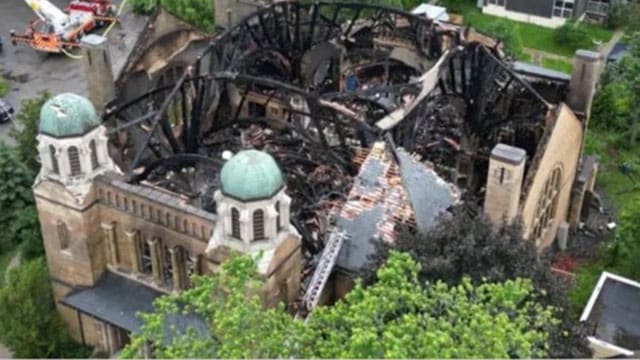A devastating fire engulfed St. Anne’s Anglican Church and destroyed its priceless Group of Seven art
 Many Torontonians woke up on June 9 to the shocking news that a historic building, St. Anne’s Anglican Church, was on fire. Within a few hours, the flames had engulfed the church and completely destroyed it. (This incident is being investigated at the time of this writing and isn’t being treated as arson.)
Many Torontonians woke up on June 9 to the shocking news that a historic building, St. Anne’s Anglican Church, was on fire. Within a few hours, the flames had engulfed the church and completely destroyed it. (This incident is being investigated at the time of this writing and isn’t being treated as arson.)
St. Anne’s was originally built in 1862 and formally established the following year. The church was situated in the old village of Brockton, which has retained its name as a Toronto neighbourhood and is also known as Little Portugal. The current building, which was designed in the Byzantine Revival style, was constructed between 1907 and 1908. It was designated under the Ontario Heritage Act in 1980 and as a National Historic Site of Canada in 1996.
The fire that brought down St. Anne’s has had a ripple effect on the city. It also pulled at the heartstrings of the local community that relied on the church for religious purposes and non-religious functions.
 St. Anne’s Anglican Church |
| More by Michael Taube |
| What Doug Ford actually said about racism and immigration
|
| Rex Murphy was a Canadian Icon
|
| How two former PMs wanted to save 24 Sussex Drive for future generations
|
Which isn’t to say all hope is lost. Far from it.
Toronto Mayor Olivia Chow noted the “spirit of the place … how they are so compassionate to everyone around them – will still be there.” Ontario NDP leader Marit Stiles echoed these sentiments. “This is going to be a tremendous loss for the community, but it’s not over because we will rebuild.”
The local congregation feels the same way. “We continue on as church and we will remain a parish community and a church for all,” Father Don Beyers, the parish priest, wrote on St. Anne’s website. “Yesterday’s fire was not the end of the story, but rather the beginning of a new chapter. We will rise from the ashes stronger and even more committed to our mission to be a church for all people.”
These are all positive statements. If the will is there, and a significant amount of funding is raised, St. Anne’s could potentially be rebuilt within a few years’ time. It will be a struggle at times. The church will need to find a new location to hold weekly services and prayers. Nevertheless, it can be done.
The loss of this historic church is irreplaceable, however. It won’t be, and obviously can’t be, the same as it was before. In particular, the great art by the Group of Seven that had adorned the church’s interior for over a century.
Canon Lawrence Skey commissioned artwork from several Canadian artists for St. Anne’s in 1923, including Thoreau MacDonald and Arthur N. Martin, as well as sculptors Frances Loring and Florence Wyle. The project was led by J.E.H. MacDonald, a founding member of the Group of Seven. He brought in two additional members of the famous group of Canadian artists, F.H. Varley and Franklin Carmichael.
How did this arrangement materialize? Charles C. Hill’s The Group of Seven: Art for a Nation noted that Skey was a “member of the Arts of Letters Club” in Toronto. It’s the same club where MacDonald, Varley and Carmichael first met, along with other Group of Seven members like Arthur Lismer and A. Y. Jackson – and its most notable associate, Tom Thomson.
“The church was in the Byzantine style,” Hill wrote, “and MacDonald painted the dome a deep Venetian red with emblems in cream white.” MacDonald also painted The Crucifixion, while Varley painted The Nativity, and Carmichael added “further scenes from the life of Christ” in the chancel.
MacDonald had hoped that Canadian motifs would be included in the church’s interior. As he wrote in 1925, this included “the trillium and other flowers … a little zoo of our own, hawk, blue jays, robins, wild ducks, orioles, deer, moose, beaver and squirrels.” This wasn’t realized, but Hill noted that “the effectiveness of the decoration should have inspired other commissions.”
Alas, nothing materialized for nearly five years.
This didn’t detract from what the Group of Seven painters and other artists created in the domed ceiling of St. Anne’s. The Globe and Mail accurately described the church as “one of the most beautiful in Canada” in 1937. It was an artistic marvel in a country where great painters and sculptors didn’t typically leave a significant mark in a house of worship. “It’s almost hard to describe how beautiful the works were and how rare,” Father Beyers told the Canadian Press. “It was the only religious artwork to my knowledge that the Group of Seven ever did.”
Having read, studied and occasionally written about Thomson and the Group of Seven, as well as visiting St. Anne’s to admire its artwork, I believe he’s right. Unless something unknown exists in a private collection, that’s all there ever likely was.
Sadly, the fire that destroyed the historic St. Anne’s Anglican Church ensures that’s all there ever will likely be.
Michael Taube, a Troy Media syndicated columnist and political commentator, was a speechwriter for former Prime Minister Stephen Harper. He holds a master’s degree in comparative politics from the London School of Economics.
For interview requests, click here.
The opinions expressed by our columnists and contributors are theirs alone and do not inherently or expressly reflect the views of our publication.
© Troy Media
Troy Media is an editorial content provider to media outlets and its own hosted community news outlets across Canada.

